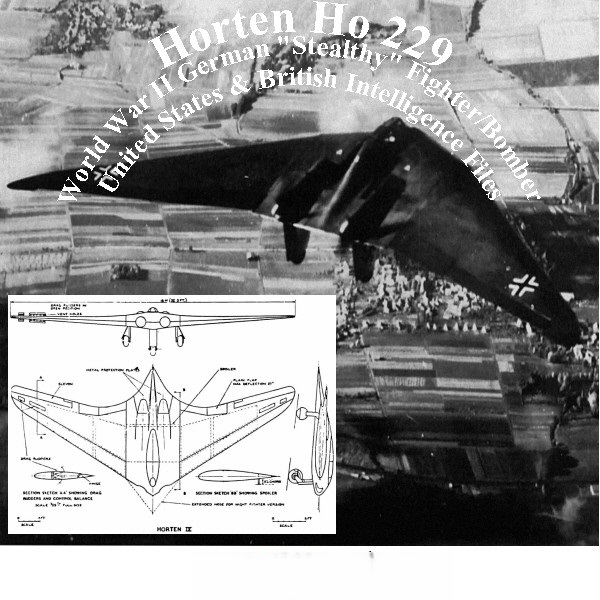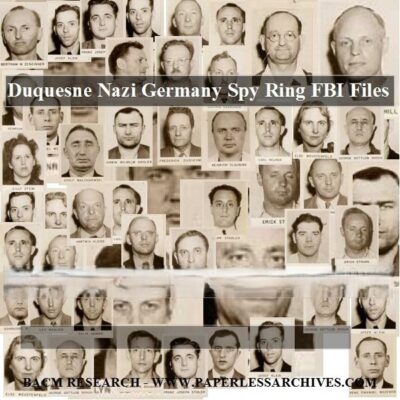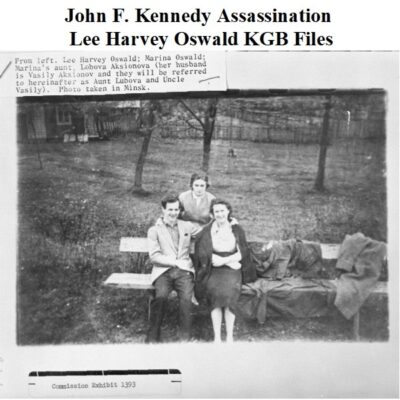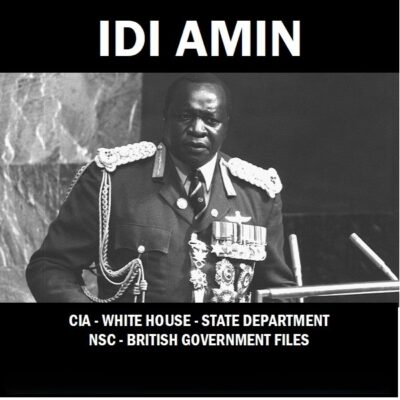
Horten Ho 229 German “Stealthy” Fighter/Bomber Aircraft American & British Intelligence
$19.50
Description
Horten Brothers, the Ho 229, and Early Stealth Concepts
Detailed Timeline of Main Events:
Early 1930s:
- The Horten Brothers begin working on flying wing design gliders.
1943:
- Mid-year: Reichsmarschall Hermann Göring presents the “3 X 1000” goal to the German aircraft industry, seeking an aircraft capable of carrying 1000 kg of bombs, with a range of 1000 km, at a speed of 1000 km/h.
- The Horten Brothers, believing their low-drag glider designs could meet Göring’s demands, begin focusing on a jet-propelled flying wing.
- Göring awards 500,000 Reich Marks to the Horten Brothers to build and fly prototypes of their all-wing, jet-propelled design, the H.IX.
March 1944:
- The Hortens test fly the unpowered glider prototype, the H.IX V1. The design is unlike any existing World War II aircraft and impresses Göring.
Late 1944 – Early 1945:
- Göring transfers the H.IX project from the Horten Brothers to the German aerospace company Gothaer Waggonfabrik.
- At Gothaer, the design undergoes significant improvements.
February 2, 1945:
- The jet-powered prototype, the H.IX V2 (also known as Ho 229 V2), makes its first flight. Several more test flights follow.
March 12, 1945:
- The Ho 229 is officially added to the German Jäger-Notprogramm (Emergency Fighter Program).
March 1945:
- A Combined Intelligence Objectives Sub-Committee team visits the original home of Horten Aircraft in Bonn soon after American troops take control.
- The Royal Aircraft Establishment (RAE) in England interrogates the Horten Brothers.
- An RAE team visits sites in Germany where Horten aircraft were assembled to collect any remaining aircraft.
April 14, 1945:
- The American 3rd Army’s VII Corps reaches the Gotha plant in Friederichsroda, effectively ending work on the next prototype version of the Ho 229, the H.IX V3, and the Horten H.XVIII “Amerika Bomber.”
August 15, 1945:
- Japanese officials order the destruction of much of the documentation from their anti-radar coverings research.
1945:
- The Intelligence Department of the Air Materiel Command creates “Technical Report No. 76-45 on Horten Tailless Aircraft,” focusing on the H.X V2 and the H.VIII, with information dating back to 1931, collected from captured documents and an informant.
- The Royal Aircraft Establishment (RAE) produces a 75-page report on the “Horton Tailless Aircraft” based on investigations and interviews conducted in Germany.
1947:
- The United States Army’s Counter Intelligence Corps (CIC) in the European Theater begins an investigation to learn the whereabouts and current activities of the Horten Brothers, fearing they might be working for the Russians.
Late 1940s – Early 1950s:
- The CIC interviews scientists and individuals in the German aircraft industry to gather information about the Horten Brothers and their wartime work.
- A CIC agent eventually locates and interviews the Horten Brothers.
May 1950:
- Reimar Horten publishes an article in the Argentine aerospace magazine Revista Nacional de Aeronautica, discussing how the advent of radar made wood construction relevant again due to its low radar reflectivity.
June 1960:
- A 38-page report titled “Performance Analysis of the Horten IV Flying Wing” is produced under the sponsorship of the United States Army Transportation Command and Office of Naval Research.
Late 1970s – Early 1980s:
- Information begins to leak to the media about the United States’ development of aircraft with stealth technology.
1983:
- Reimar Horten writes in his book Nurflugel: Die Geschichte der Horten-Flugzeuge 1933-1960 about his intention to use a mixture of sawdust, charcoal, and glue in the H.IX’s wing construction to absorb radar waves and shield the aircraft.
2008:
- Northrop-Grumman builds a full-size reproduction of the Ho 229 V3 using materials available in Germany in 1945. They also study the surviving parts of a Ho 229 V3 at the Smithsonian.
- Northrop-Grumman tests the reproduction at their radar testing facility, finding that the H.IX design provided a significant reduction in radar range detection compared to conventional fighters of the time.
Cast of Characters:
- Reimar Horten: (Mentioned throughout the documents) One of the Horten Brothers, central figures in the development of tailless flying wing aircraft in Germany. He co-designed the Ho 229 and other aircraft. After the war, he continued to reflect on the design principles and even discussed the potential for radar reduction. He emigrated to Argentina after the war.
- Walter Horten: (Mentioned throughout the documents) The other of the Horten Brothers, who collaborated with Reimar on their innovative aircraft designs. He was also involved in the development of the Ho 229 and their earlier gliders.
- Hermann Göring: (Mentioned in the documents) Head of the German Luftwaffe (Reichsluftwaffe) and a prominent figure in the Nazi regime. In 1943, he set the “3 X 1000” goal that spurred the development of aircraft like the Ho 229. He was impressed by the Horten design and initially supported its development.
- William Green: (Mentioned in the documents) Author of “Warplanes of the Third Reich.” The source quotes him stating that the Ho 229 was the first “flying wing” aircraft with a jet engine and the first plane with design elements that could be considered stealth technology.
- Tom Dobrenz: (Mentioned in the documents) A Northrop Grumman stealth expert involved in the 2008 testing of the Ho 229 reproduction. He provided an assessment of the aircraft’s radar signature reduction capabilities.
- Unnamed Draftsman (Informant): (Mentioned in the “HORTEN TAILLESS AIRCRAFT – CADO INTELLIGENCE DEPARTMENT” report) An individual who worked for the Horten Brothers and was in close contact with them until his capture. He provided valuable information to U.S. Naval Technical Mission Europe about Horten aircraft designs.
- CIC Agent (Unnamed): (Mentioned in the “COUNTER INTELLIGENCE CORPS FILES”) A member of the United States Army’s Counter Intelligence Corps who was tasked with investigating the whereabouts and activities of the Horten Brothers after World War II. The agent eventually located and interviewed them.
Horten Ho 229 German “Stealth” Fighter/Bomber & Other Horten Aircraft American & British Intelligence Documents
468 pages of material covering the Horten Brothers and thier aircraft.
Includes 369 pages of United States and British intelligence documents covering the development of aircraft designed by the brothers Reimar and Walter Horten, including the Horten HO 229. Recently this plane has also been called “Hitler’s Stealth fighter”, even though the plane’s stealth capabilities may have been incidental.
An additional United States intelligence report shows that the Japanese were developing technology that was much more explicitly stealth than what was applied to the Horton Ho 229.
The Horten Ho 229 is known by several different names. The Horten Brothers called the plane the H.IX, so it is often called the Horten H.IX. Reichsluftfahrtministerium, the German Ministry of Aviation, gave the plane the identity Ho 229. At times it is referred to as the Gotha Go 229, due to the German manufacturer chosen to produce the plane, Gothaer Waggonfabrik. According to William Green, author of “Warplanes of the Third Reich,” the Ho 229 was the first “flying wing” aircraft with a jet engine. It was the first plane with design elements, which can be referred to as stealth technology, to hinder the effectiveness of radar to detect the plane.
In 1943, the head of the German Luftwaffe, Reichsmarschall Hermann Göring, presented to the German aircraft industry what is known as the “3 X 1000” goal. Goring wanted a plane that could carry 1000 kg of bombs (2,200 lb), with a range of 1000 km (620 miles), at a speed of 1000 km/h (620 mph). The Horten Brothers had been working on flying wing design gliders since the early 1930’s. They believed that the low-drag of the gliders they made in the past could be the basis for a craft that would meet Goring’s demands. The H.IX’s wings were made from two carbon injected plywood panels adhered to each other with a charcoal and sawdust mixture.
In 1943, Göring awarded 500,000 Reich Marks to the Horten Brothers to build and fly several prototypes of the all-wing and jet-propelled Horten H IX. The Hortens test flew an unpowered glider, the prototype H.IX V1 in March of 1944. The aircraft did not look like any existing plane in use during World War II. It looked very similar to the modern American B-2 Bomber. Goering was impressed with the design and transferred it away from the Hortens to the German aerospace company Gothaer Waggonfabrik.
At Gothaer the design went through several major improvements. The result was a jet powered prototype, the H.IX V2, which was first flown on February 2nd, 1945. After several more test flights, the Ho 229 was added to the German Jäger-Notprogramm, or Emergency Fighter Program on March 12, 1945.
Removed from the project, the Horten Brothers were working on the Horten H.XVIII, also called the Amerika Bomber. The Horten H.XVIII was an attempt to fulfill the German desire to build a bomber that could reach the United States.
Work on the next prototype version of the plane, the H.IX V3, ended when the American 3rd Army’s VII Corps on April 14, 1945 reached the Gotha plant in Friederichsroda.
In 2008, Northrop-Grumman using available design plans built a full-size reproduction of the H.IX V3 using materials available in Germany in 1945. They also studied the only surviving parts of a Ho 229 V3, which were housed at the Smithsonian National Air and Space Museum’s Paul E. Garber Restoration and Storage Facility just outside of Washington DC in Suitland, Maryland.
Engineers at Northrop wanted to find out if the German craft could actually be radar resistant. Northrop tested the non-flying reproduction at its restricted radar testing facility in Tejon, California. During the testing the frequencies used by British radar facilities at the end of the war were directed at the reproduction. Tom Dobrenz, a Northrop Grumman stealth expert said about the H.IX, “This design gave them just about a 20 percent reduction in radar range detection over a conventional fighter of the day.”
When combined with the speed of the H.IX, after detection by British homeland defense radar, the Royal Air Force would have had 8 minutes from the time of spotting the aircraft before it reached England, instead of the usual 19 minutes.
While the design was proven to be stealthy, it has been argued that it was not designed to stealthy. There is no documented evidence in Germany that the design was intended to be what would later be called stealth.
In an article written by Reimar Horten published in the May 1950 edition of the Argentine aerospace magazine Revista Nacional de Aeronautica, Reimar wrote, “…with the advent of radar, wood constructions already considered antique, turned into something modern again. As reflection of electric waves on metallic surfaces is good, such will be the image on the radar screen; on the contrary, on wood surfaces, that reflection is little, these resulting barely visible on the radar.”
In the late 1970s and early 1980s, information began to leak to the media that the United States was working on aircraft with stealth technology.
In 1983, Reimar Horten wrote in Nurflugel: Die Geschichte der Horten-Flugzeuge 1933-1960 (Herbert Weishaupt, 1983) that he had planned to combine a mixture of sawdust, charcoal, and glue between the layers of wood that formed large areas of the exterior surface of the H IX wing to shield, he said, the “whole airplane” from radar, because “the charcoal should absorb the electrical waves. Under this shield, then also the tubular steel [airframe] and the engines [would be] “invisible” [to radar]”
By 1983, the basic elements of American stealth technology were already public knowledge.
DOCUMENTS
HORTEN TAILLESS AIRCRAFT – CADO INTELLIGENCE DEPARTMENT
A 26 page report created in 1945 during World War II by the Intelligence Department of the Air Materiel Command titled, “Technical Report No. 76-45 on Horten Tailless Aircraft.”
This report focuses on the H.X V2 and the H.VIII. The report contains information about other Horten aircraft dating back to 1931. The information in this report was collected by the U.S. Naval Technical Mission Europe from captured documents and partly from an informant who was a draftsman for the Horten Brothers. The informant is reported to have been in continuous close contact with the Horten Brothers, until the time of his capture.
THE HORTON TAILLESS AIRCRAFT RAE REPORT
This 75 page, October 1945 report was produced by the British aircraft authority, Royal Aircraft Establishment, Farnborough.
It was produced from information gained in March 1945, soon after American troops took control of Bonn, by a Combined Intelligence Objectives Sub-Committee team visiting the original home of Horten Aircraft. Also from an interrogation in England of the Hortens performed by a party from RAE. This was followed by a RAE team visiting sites in Germany where Horten designed aircraft were assembled. They were tasked with returning to England any remaining aircraft. Finally, a RAE team returned to Germany to interview the brothers and others in the field of German aviation.
COUNTER INTELLIGENCE CORPS FILES
268 pages produced by the United States Army’s Counter Intelligence Corps (CIC) in the European Theater concerning the Horten Brothers. The files contain approximately 160 discernible and narrative pages concerning an investigation that began in 1947 to learn the whereabouts of the Horten Brothers and their current activity. The CIC interviewed scientists and individuals in the German aircraft industry to learn about the Hortens and their work. Some of those interviewed provided information concerning the work of the brothers during World War II. The CIC feared that the Hortens may have been working on developing aircraft for the Russians. A CIC agent finally found the brothers and interviewed them and to find about their current activity. A CIC agent wrote in his report concerning his contact with the Hortens, “Both brothers are exceedingly peculiar and can be easily classified as eccentric and individualistic.”
EXTRA MATERIAL
Also included in the collection
TARGET REPORT – JAPANESE ANTI-RADAR COVERINGS
Also included in this collection is the 12 page Naval Technical Mission to Japan intelligence report, “Target Report – Japanese Anti-Radar Coverings.” The report shows that Japan was more on track in developing what would be called stealth technology. From the report’s introduction:
“Japanese research in the field of anti-radar coverings was quite intense, and while several research products proved to be rather successful, according to the data presented, it was difficult to use, in practice. Such information as was available is included in this report, and was obtained from the Air Technical Intelligence Group, which initiated the request for interrogations, data and samples.”
Japanese researchers were working on specifically creating a process to reduce radar detection. Their approach was to research rubber coverings containing carbon powders and anti-radar paint. The research ended with the end of World War II. Much of the documentation from the experiments was ordered destroyed by Japanese officials on August 15, 1945.
PERFORMANCE ANALYSIS OF THE HORTEN IV FLYING WING
A June 1960 38 page report of work done under the sponsorship of the United States Army Transportation Command and Office of Naval Research, to study the characteristics of Horten aircraft.






